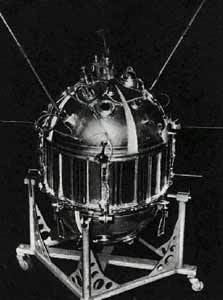Harvard designation 1962 Iota 1 Launch mass 285 kilograms (628 lb) Launch date 6 April 1962 | Bus 1MS Decay date 20 August 1963 | |
 | ||
Manufacturer S. P. Korolev Rocket and Space Corporation Energia | ||
Kosmos 2 (Russian: Космос 2 meaning Cosmos 2), also known as 1MS #1 and occasionally in the West as Sputnik 12 was a scientific research and technology demonstration satellite launched by the Soviet Union in 1962. It was the second satellite to be designated under the Kosmos system, and the first spacecraft to be launched as part of the MS programme. Its primary missions were to develop systems for future satellites, and to record data about cosmic rays and radiation.
It was launched aboard Kosmos-2I 63S1 s/n 5LK. It was the fourth flight of the Kosmos-2I, and the second to successfully reach orbit. The launch was conducted from pad 2 of the Mayak Launch Complex at Kapustin Yar, and occurred at 17:15 UTC on 6 April 1962.
Kosmos 2 was placed into a low Earth orbit with a perigee of 207 kilometres (129 mi), an apogee of 1,485 kilometres (923 mi), 49 degrees of inclination, and an orbital period of 101.8 minutes. It decayed on 20 August 1963.
Kosmos 2 was a 1MS satellite, the first of two to be launched. The second was launched on 25 October 1962, but failed to reach orbit. The 1MS was the first of two types of MS satellite to be launched, and was succeeded by the 2MS satellite.
